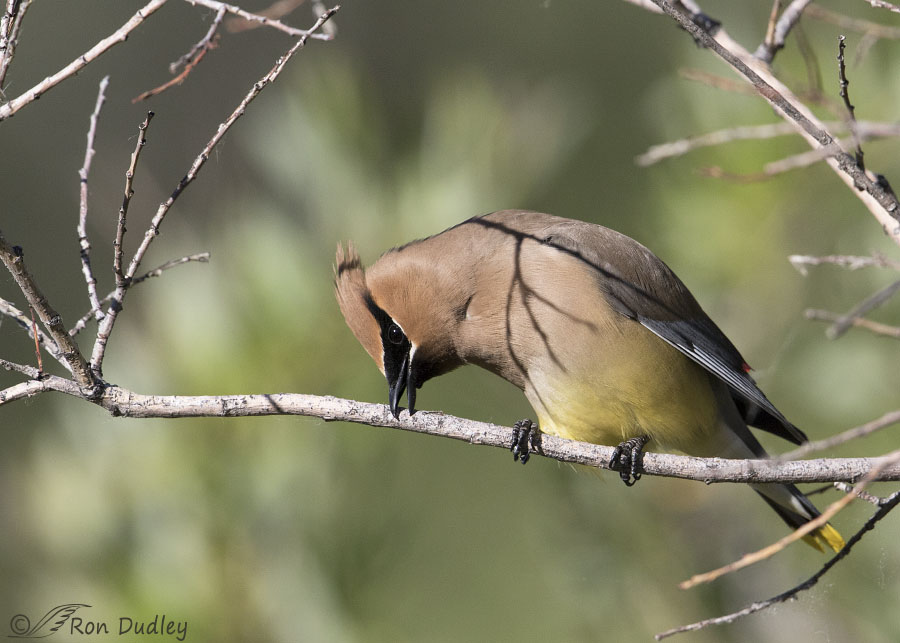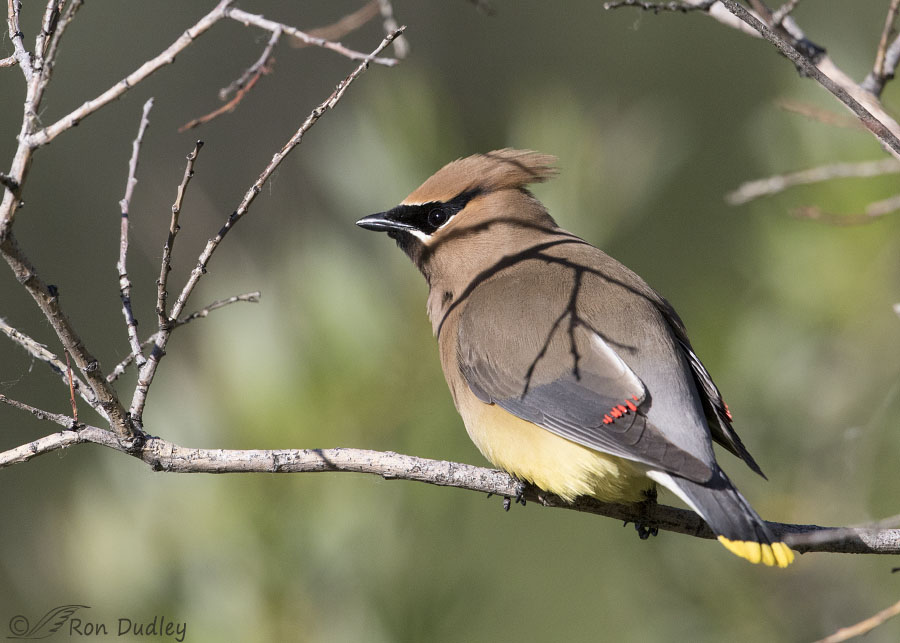What are they made of? What’s their purpose? And why do some waxwings have more red waxy tips than others and some individuals don’t have any at all?
But first a little whimsy.

1/3200, f/6.3, ISO 800, Canon 7D Mark II, Canon EF 500mm f/4L IS II USM + EF 1.4 III Extender, not baited, set up or called in
I photographed this waxwing in the Wasatch Mountains yesterday as it was cleaning its bill. It’s one of the best views of bill cleaning I’ve ever captured.
Normally I’d avoid posting an image where the subject has such a strong shadow across its body because shadows tend to distract from the bird. But I actually kind of like this one because of its graphic lines that resemble the shape of a bird’s foot – how appropriate is that! And to add to the whimsy, the 3-branched twig to the left of the waxwing also mimics that same bird’s foot shape.
And for obvious reasons that twig couldn’t have caused the shadow on the bird so there must have been another one of almost exactly that same shape out of frame that did. For some reason that coincidence amuses me.

1/3200, f/6.3, ISO 800, Canon 7D Mark II, Canon EF 500mm f/4L IS II USM + EF 1.4 III Extender, not baited, set up or called in
Ok, now to those red, waxy feather tips on their secondaries which can clearly be seen here after the same bird turned around on its perch.
Those tips are actually small appendages on the bird’s secondaries and they’re composed of a red, waxy secretion called astaxanthin – a carotenoid pigment. For years it was thought that their purpose is to protect the feathers from wear and tear but there’s virtually no evidence to support that. Instead, many ornithologists now believe they function as status symbols in mate selection.
Those appendages increase in both number and size as a bird becomes older. Individuals with fewer waxy tips (say 0-5) are younger and those with up to 9 are older. Those with more tips tend to choose other older birds (also with more red tips) as mates and those birds nest earlier and raise more offspring than younger waxwings (those with fewer tips). So it seems that the tips are important signals in choice of mates and social organization – they’re plumage enhancements that signal age, maturity and social status to other waxwings, especially during courtship.
Another striking plumage feature of Cedar Waxwings is their bright yellow tail tip. But in the 1960’s, for the first time, waxwings started appearing with bright orange tail tips instead of yellow. Cedar Waxwings are gluttonous berry-eaters and it turns out that orange-tipped birds had been eating large quantities of berries from a recently introduced species of honeysuckle that caused their tail tips to absorb a new pigment as the new feathers were growing in during molt. Orange tail tips were the result.
Thought I’d throw out that last little tidbit just for the fun of it…
Ron


I did not know about either…the red tips or the yellow/orange tail. Thank you Ron 🙂 It’s nice to learn new things.
Just returned from a photo shoot with husband Bob, so I’m late reading this. Fascinating! Thank you for the lesson, Ron.
Thank you, Nancy.
Just a quick add on…my serviceberry tree and shrubs were pillaged by a flock of at least fifteen of these beauties late morning today and continue to be all afternoon. I suspect they will hang around a few days till they have cleaned them out! Robins and Cardinals have joined in on the fun. Needless to say my camera has been busy! Love these guys! 😊
Sounds like lots of photo-ops, Kathy.
Absolutely captivating images. Museum quality for my money. Explanations are icing on the cake.
Thank you, Lyle.
How interesting about the explanation of the colors! I never knew that.
Thank you, Ron.
I’m glad you liked it, Adele. Thanks.
I believe Waxwings are also the ones who will overdo on the berries which will ferment and make them drunk. I heard that somewhere.
It’s true, Arwen.
It reminds me of the buck with the biggest antlers most often wins over the female in courting. Of course I have no proof, but it just makes sense to me.
This is truly a handsome bird and the colors really add to the beauty. I’ve never thought about a bird cleaning its bill but see why they have to do it.
Thank you Ron, for the photos and the informative post.
Thanks, Alice. Bill cleaning is such a common behavior it’s been given a name – feaking.
How interesting that status symbols are so often red. And yes, I am thinking of older men in shiny red cars. Which I suspect are not nearly as successful as those red waxy tips. Which I hope are not nearly as successful.
Interesting point, EC.
Absolutely fascinating information about those red waxy tips. And it’s interesting to know that their feather color can be influenced by what they eat. I guess that shouldn’t be a surprise because that’s how adult Flamingoes get their color. I also like the shadows on the bird – mostly shadows just obliterate detail on the bird, but these twig shadows add interest to the photo (IMO).
Susan, a fair number of birds get some of their plumage color from their diet, including Western Tanagers I believe.
Many thanks for tickling my memory. Great shots, simply a beautiful species. Too bad Bohemian’s aren’t in your area for contrast. Maybe they are in some winters?
I think they’re sometimes seen around here, Dick.
Thanks for the very interesting and informative information. Waxwing feathers are amazing.. the breast feathers are so delicate-looking with such beautiful hues.
When I was a teenager we found a waxwing with a badly injured wing. We brought it in our home to care for it and it quickly became a friendly family pet. When we put our Christmas tree up, it became a permanent moving ornament in the tree! We left the tree up for a couple of months until it dried out so bad we had to remove it. Then my mom made a tree with a using a thick dowel with small holes drilled holes drilled up and down the length of the dowels. We stuck short small diameter dowels through the holes forming branches in the shape of a spiral staircase. The waxwing would hop from branch to branch within in his new tree. We named him WOW, short for Wilbur Orville Wrong because he couldn’t fly and Wilbur and Orville Wright could fly!
Fascinating story, Peggy. Thanks for telling it.
Amazing…I was just looking around my yard 10 minutes ago and two cedar waxwings flew into a tree! First time I have ever seen them in my yard or anywhere within 5 miles of my yard!
Neat!
Someone asked why “cedar,” and the name, Bombycilla cedrorum, means “Silky tail of the cedar tree,” because, I assume, they eat fruit and berries, including juniper berries. But with scientific names, often a polyglot of Greek, Latin, and who knows what, indeed, who does know what?
Sallie, see my response to Frank, below.
Ron, do you know if the yellow/orange tail tips are also “wax” – that is, made of astaxanthin?
No, I don’t, Sallie. But I doubt it.
You provide such fascinating information ! I wonder if a progressive astaxanthin accumulation on the wingtips might signify a successful berry-finder to a
potential mate–besides being “flashy”, it could be a sign of robust health as well as beauty !
Good question, Kris. That does seem both possible and logical.
Thanks for the lesson on Waxwings Ron. You had previously provided a hint and now appreciate the additional detail. Now we need to know why “cedar”.
Frank, the following quote from BNA Online about Cedar Waxwings answers your question”
“Cedar berries historically dominated winter diet (Witmer 1996a); wintering populations still concentrate in regions with abundance of cedars.”
Ron – great photos. Love Cedar Waxwings – such colorful birds. In your first sentence of the last paragraph I think you meant to say bright orange tail tips instead of yellow …….. you have instead of red. Have a good weekend. And thank you for the education once again. During their season here I always think about the red wax, but have never taken the time to look it up.
Everett Sanborn, Prescott AZ
Thanks, Everett.
Actually my error was in the second sentence instead of the first but you’re right. Thanks for the heads up. I fixed it.
Huh! 🙂 Interesting! Wonder if the red “wears” as the season progresses? Also interesting that diet would affect the yellow….:) Just beautiful birds for sure. The whimsy is fun 🙂
“Wonder if the red “wears” as the season progresses?”
Good question, Judy. I don’t know.
Glad you enjoyed the whimsy. I thought I might be the only one… 🙂
Hmmm, guess it proves the adage ‘You are what you eat’. 😊 Love that second photo. The tip colors have always amazed me…so perfect that they do not look real…the shine makes them look like nail polish.
Good point about that adage, Kathy – an excellent example.
Great shots and very interesting info Ron!
Charlotte
Thank you, Charlotte.
Thank you Ron, I learned two new interesting facts today!
You’re very welcome, D.
Beautiful photographs, I love Cedar Waxwings. Thank you for sharing the information about their colors, I love learning about these birds.
Good, I’m glad you do, Jerilyn. Thanks.